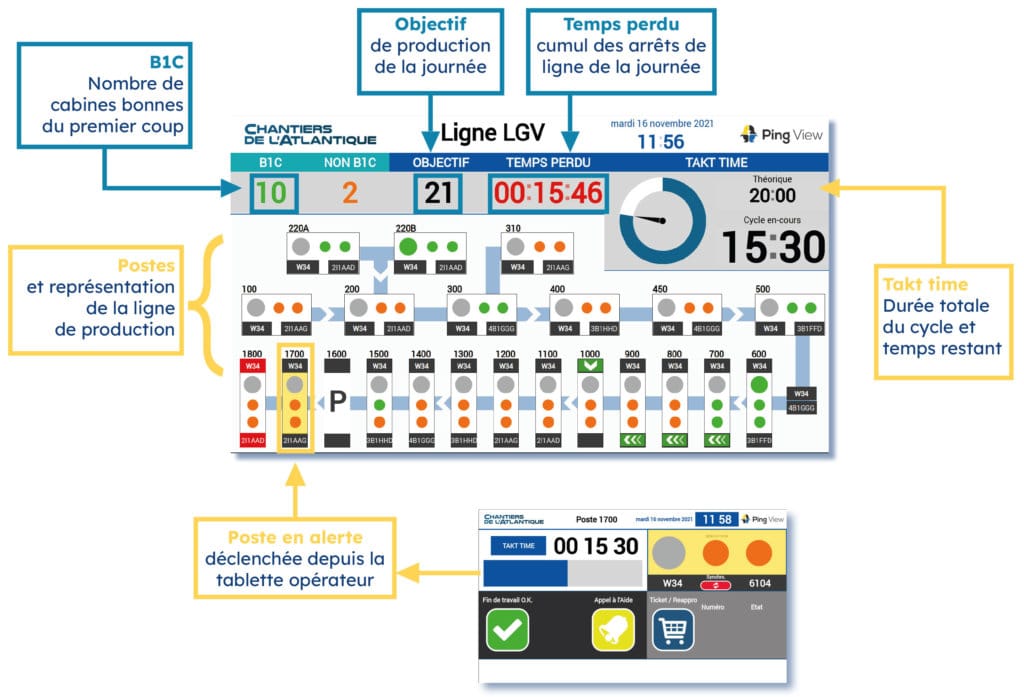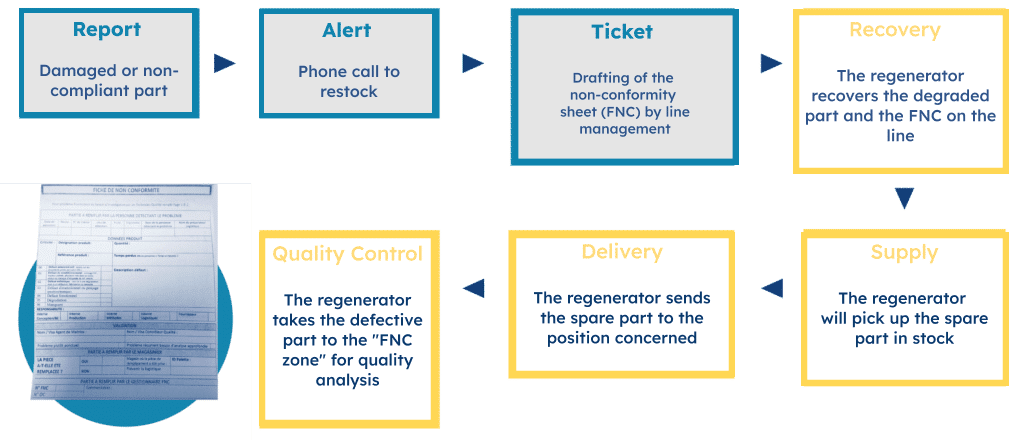From actual production to supplies, the Chantiers de l’Atlantique passenger liner cabin assembly unit has gained 15 productivity points in just a few years. Thanks to an andon alert and digital piloting project carried out at full speed.
Production lines active more than 90% of the time, a constantly decreasing takt-time, less overtime… and an ever more peaceful climate: at Chantiers de l’Atlantique, the results of the efforts made in terms of excellence operational are spectacular.
Why? A continuous improvement approach that has made it possible to anticipate hazards and resolve them (much) faster, throughout the production chain.
The Chantiers de l’Atlantique, cradle of the giants of the seas
Normandy, France, Queen Mary 2, Harmony of the Seas… It is in Saint-Nazaire, in the Chantiers de l’Atlantique workshops, that these famous giants of the seas were assembled. Since 1862, the company has become a reference in the construction of ocean liners, but also military ships and more recently offshore wind turbines. These are all markets in which demand is very strong, and where production is therefore constantly under pressure.
The cabin production unit: 5 takted and clocked lines
About ten kilometers from the main site, a smaller unit (26,000 square meters and 350 operators, all the same…) specializes in the prefabrication of cabins, which are then embarked and finished on board the liners.
In this workshop, 5 production lines, taktées et cadences, allow to assemble the various models of cabins (crew, standard, family, for people with reduced mobility…) and their sanitary blocks, at a rate of 2000 to 2500 cabins per ship on average. Each liner occupies this production unit for a period of 4 to 6 months.

On the lines, lean objective!
“The first observation that we can make, explains Aurélien Caillaud, is that our lines have no work in progress: we are constantly in pull mode. Consequence: the slightest hazard on one of the 20 workstations on each line will cause a stoppage, and block the 70 operators who work there”.
To resolve a hazard as soon as it arises, the Chantiers de l’Atlantique have set up teams:
- “fielders” (on the production side), operators that team leaders or line managers will send as reinforcements to positions in tension,
- fast replenishers on the logistics side, responsible for supplying spare parts to the stations that request them.
But on its own, this organization is not enough. For several years, Aurélien Caillaud, lean engineer at the Chantiers de l’Atlantique, and his predecessor François Robic before him, have therefore asked Pingflow to put in place tools to effectively adopt methods from lean management (Andon and Yo- I-Don) to manage and optimize cabin assembly lines. Goals ?
- Obtain an accurate global view, in real time, of the status of each production line:
- Identify stress positions as soon as possible and provide the most efficient solution on time;
- Synchronize the workstations and pace the lines, so that everyone starts and finishes their tasks at the same times;
- Finally, streamline intra-team communication, but also that between the production part and the logistics part.
A project carried out in 2 phases: first on the production lines, then on the logistics supply.
2019-2020: focus on production andon
The starting point: numerous and costly line stoppages
As part of a pull-flow production, there are always hazards: before starting its collaboration with Pingflow, the cabin workshop suffered an average downtime of one hour per day.
Added to these incidents was the problem of line changes (a new type of cabin that was entering production). Between two “batches”, the time for stopping and restarting the line was also one hour. Taken end to end, these delays could have a strong impact on the production rate, and therefore the delivery of the liner at the end of the chain.
Pingflow’s answer: digital andon alert from operator workstations
Quite logically, the Chantiers de l’Atlantique teams therefore first wanted to tackle the subject of line stoppages linked to actual production incidents.
With the help of Pingflow, each workstation has been equipped with a tablet that allows the operator to retrieve information such as:
- his end of work,
- a blocking incident,
- or not blocking.
These incidents are immediately transmitted by SMS and email to the team leaders, and displayed on large monitors located at strategic locations in the workshop to disseminate real-time information on the state of the activity. The interventions and reinforcements needed to resolve the incident and restart production arrive more quickly, and all line activity is monitored more closely.
In the back office, the whole system is connected to the ERP in order to provide the provisional production “film” of the day and to a web interface which allows:
- upstream, to set up working hours, user profiles and contact details,
- downstream, view incidents in the form of logs and graphs and draw a history for quality analysis.

First spectacular results
Deployed in 2019, this first andon “brick” has enabled the cabin workshop to record more than convincing results:
- Downtime divided by 3… and more: from one hour per day, the workshop went to 20, then 10 minutes/day;
- Ever more efficient lines: from 80% of the working time, the production unit has increased to 90-95%;
- A sharp drop in overtime (often necessary to “complete” the production of the week), of the order of 10%.
Bet won? Except that the Chantiers de l’Atlantique did not intend to stop there…
To learn more ; Andon System : How CLAAS digitize incident management ?
2021: a step further with logistics andon
Because after having streamlined the resolution of production incidents, the teams realized that 80% of residual line stoppages were linked to non-compliant parts: damaged sanitary block elements, degraded parts, etc.
Historically, an operator confronted with a defective part had to fill in a non-compliance form by hand, and send it to the teams of rapid replenishers so that they could pick up the spare part in stock, send it to the station in question. , and close this “ticket”. A cumbersome, time-consuming process… and therefore eminently optimizable!

Especially since it generated strong tensions between the production and logistics teams, “who passed the buck during this type of incident, observes Aurélien Caillaud. However, one of the non-quantifiable but very real benefits of setting up production andon with Pingflow was precisely a net gain in serenity in the workshop: the operators now know that the incident ‘they said is well identified and in the process of being resolved. We wanted our teams of replenishers, who are by nature subject to urgency and stress, to also benefit from calmer working conditions”
A new process co-designed with the teams concerned
To solve this problem, Aurélien Caillaud first listened to the “field”, and collected the irritants of the teams…
- … production: forms too long to fill out, unreachable replenisher, replenishment too slow, causing line stoppages;
- … logistics: poorly filled out or illegible forms, too much time on the phone, impossible to organize and concentrate on your tour;
- … quality: declarations of untraceable and unusable non-conformities.
Not easy, especially in the context of these workshops:
- very large (26,000 m2), therefore with long rounds
- with many references (3000 per cabin), therefore complex replenishments
- more and more cadenced, with a takt time divided by 1.5 over the last 5 years (it has gone from 30 to 19-20 minutes on average)
From 100% paper to 100% digitized: 100% efficient logistics andon
It is thanks to this phase of listening to the field that Aurélien Caillaud was able to deploy with Pingflow a logistics andon system adapted to the needs of his internal “customers” from the three production, logistics and quality departments, of which he himself gives you the demonstration.
Velocity, productivity, serenity: green indicators!
By digitizing this entire alert process, and eliminating paperwork and irritants from the replenishers’ journey, Chantiers de l’Atlantique again saw huge productivity gains:
- On the speed of operations, with a restocking time reduced by more than half: from 33 minutes before, we are now at 12-13 minutes on average;
- On securing takt time: these express replenishment times leave a margin on the current cycle, which is already down sharply;
- On the efficiency of the lines overall: from 700 minutes of downtime per month, the workshop has gone to 200-250 minutes;
- On quality monitoring, the teams now have a real dashboard allowing them to identify and measure deviations by supplier, by part, etc. and therefore to take the appropriate measures;
- On the serenity of logistics operators, now much more in control of their time and their rounds.
In the pipes: innovations that spread throughout the production chain
Committed to a process of continuous improvement, the Chantiers de l’Atlantique will now capitalize on the steps taken during the first 2 phases of the project, to push the management of the activity even further, with:
- a “picking” andon, in order to optimize logistics beyond emergency restocking, in particular for the train which supplies the lines from stocks
- real-time information on the state of production for logistics, in order to restore visibility to the latter.
The key success factors of the Chantiers de l’Atlantique project
The remarkable results observed by the cabin assembly unit are neither miraculous nor the result of chance. But above all the consequence of a well-conducted project based on 3 key factors:
- A progress prioritized by “batches”: rather than a global “mega-project” (but which would perhaps never have seen the light of day), the Chantiers de l’Atlantique proceeded in stages. First the most urgent problem (line stoppages on the production side), then after this first success priority number 2 (restocking), finally a further generalization;
- A respected learning curve: the teams took the time to observe the first results, to list the points for improvement, before iterating;
- Listening to the field as a cardinal virtue: the user is king, and all the tools and interfaces have been designed to respond as simply as possible to the needs expressed.

